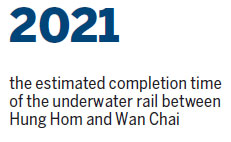Byass delay may affect plans to relieve traffic congestion
Updated: 2015-09-18 09:03
By Kahon Chan in Hong Kong(HK Edition)
|
|||||||
A half-year delay of a bypass highway to divert traffic away from the heart of Hong Kong Island will likely hold up three initiatives which could make traveling quicker. These include the city's fourth cross-harbor railway line and the long-delayed road charging scheme.
Reclamation for the Central-Wan Chai Bypass has been halted for about six months since last December. This is after contractors discovered a "large metal object" which appeared to be part of a shipwreck. Historians believe it could be the HMS Tamar which was scuttled before the Japanese occupation.
The delay has since held up completion of tunnel works until mid-2017. The Highways Department on Sept 15 confirmed contractors will not finish paving the road and installing systems before the end of 2017. This means the new bypass will miss the original commissioning date of the end of 2017. A new date has not yet been decided.
The shipwreck might only be part of the reason - according to documents provided by the Transport and Housing Bureau to the Legislative Council in March. Contractors working on the bypass had already informed builders of the Shatin to Central Link last December that handing over key sites could be delayed by six months.
The harbor-crossing commuter railway will allow commuters from Sha Tin to arrive in Admiralty via a single ride. The line will also expand the reach of the MTR to Kowloon City and To Kwa Wan. These are dense neighborhoods in Kowloon which still depend on buses for mass transit.
A spokesperson for the MTR Corporation, which will operate the rail link, told China Daily that they were not able to fully assess the impact until departments provided further details.
Former rail boss and lawmaker heading the panel on transport, Michael Tien Puk-sun, said he was worried the new rail link would miss the 2021 deadline owing to these delays.
The underwater rail between Hung Hom and Wan Chai will go under the underground highway; but the bypass has been the main thing delaying the rail project's progress. A court challenge of the bypass shifted the beginning of service from 2019 to 2020. A delay of the work-site transfer has further held up the rail launch until 2021.
Hung Wing-tat, a transport engineering expert at the Hong Kong Polytechnic University, said contractors might not be able to start working immediately after transfer of the site. Indeed, site surveying and preparations could result in last-minute design changes and add further delays to the timeline.
Tien said rail passengers might also be frustrated when new rail lines feed extra commuters into existing, overloading transit bottlenecks such as Kowloon Tong and Tsim Sha Tsui. "They may find out in the end that they are better off sticking to buses," he said.
The Tsuen Wan Line will receive commuters from Hung Hom from late 2016 when an extension of the Kwun Tong Line opens. The Shatin to Central Link will likely put further stress on the Tsuen Wan Line by 2019. The harbor-crossing section of the Tsuen Wan Line was already running at 98 percent capacity in late 2013.
Those who plan to get off trains in Hung Hom and cross the harbor by road may find this is not so easy.

But the government believes the island bypass is an opportunity to develop new initiatives to relieve road traffic on both sides of the harbor.
However, the government disappointed motorists in 2014 when it shelved a plan to evenly distribute road traffic across three cross-harbor tunnels. They will be re-examining options after commissioning the island bypass. This is because the new road will help divert traffic to the Western Harbour Tunnel without bringing Central to a standstill.
The bypass will begin service the same year the government resumes direct control of the Eastern Harbour Crossing.
Tien believes the government may consider taking control of the tunnel after 2017. That is if traffic plans are affected by the bypass delay.
In 2015, in response to a renewed push by the Transport Advisory Committee for electronic road pricing in the Central district, the government said the bypass was an essential alternative route for motorists in order to avoid being charged in Central.
A feasibility study released over 14 years ago estimated it could take five to six years to launch a road pricing scheme. This includes a public consultation. The government had announced a plan in May to commence public engagement within this year. A statement provided by the Transport Department did not provide any update. Moreover, it did not comment on the impact of the bypass delay.
kahon@chinadailyhk.com
(HK Edition 09/18/2015 page7)